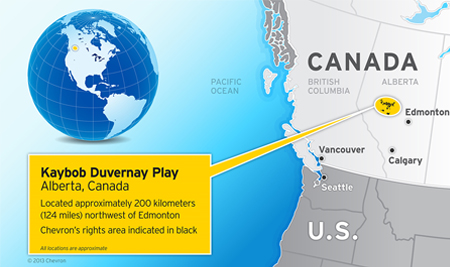Over the past few years a handful of energy majors have quietly acquired large tracts of land in a little known Alberta shale play.
Early estimates suggest that this field could contain 62 billion barrels of oil...large enough to rival the Texas Eagle Ford and the North Dakota Bakken.
And their bet is starting to pay off. Many of the area's big leaseholders just reported incredible numbers from their exploration in the region. And this is only the beginning.
Is this North America's next big shale play?
As longtime readers know, Alberta is Canada's energy capital. Its claim to fame is the Athabasca oil sands, which ranks as the largest energy reserve in the world available to private investment.
But there's a nearby play within the province that's catching the attention of energy majors: the Duvernay.
The field is located is located along the edges of the Canadian Rockies and covers an area about 62,000 square miles in size. To put that into perspective, that's larger than the Bakken and the Eagle Ford combined.

Source: Chevron Canada
And early reserve figures are impressive too. According to the Canadian Energy Resource Conservation Board, the Duvernay holds an estimated 443 trillion cubic feet of natural gas, 11.3 billion barrels of natural gas liquids, and 61.7 billion barrels of oil, though how many of those barrels are economically recoverable remains to be determined.
What makes the Duvernay unique from other shale plays is that it's rich in a super-light oil called condensate. This hydrocarbon is used as a lubricant. It's blended with bitumen, a tar-like oil product, so that it can flow freely through a pipeline. With diluent demand soaring from nearby oil sands development, the price of condensate trades at a 10% premium to West Texas Intermediate. Essentially, this is one of the most valuable fuel blends in the world.
The smart money is moving in
Dozens of smart money operators are moving into the Duvernay. And they like what they see.
In October, Chevron (CVX +0.64%) announced the successful conclusion of its exploration activities in the Kaybob area. The company completed 12 wells with 30-day initial production rates up to 7.5 million cubic feet per day of natural gas and 1,300 barrels per day, or bpd, of condensate. For context, anything above 1,000 bpd is considered excellent. The results coming from Chevron are truly remarkable.
Rival companies are also reporting impressive drilling results. Earlier this year one Encana (ECA +3.88%) well produced a highly publicized 1,400 bpd of condensate and 4 mcfpd of natural gas 30 days after completion. The company has amassed 239,000 net acres in the play and is just completing its exploration program.
Other smart money operators are moving into the region as well. ConocoPhillips (COP +3.07%) is betting big on the Duvernay after it slowly acquired 250,000 net acres of land. The company is looking at the Duvernay as a possible way to deliver high-margin liquids growth in the latter part of the decade, and investors are eagerly awaiting the release of the company's drilling results.
Talisman Energy (NYSE: TLM) is the largest landowner with 347,000 net acres in the region. However, the company is looking to sell its northern properties to raise cash. These might make an attractive purchase for nearby Chevron or Encana.
The only thing holding back this petroleum bonanza is cost. Drilling a typical well in the Duvernay will set you back between $10 million and $15 million, making the field the most expensive shale play in North America. But impressive operating results still make this play economic. And expect costs to fall as drillers gain experience.
Foolish bottom line
Nevertheless, the takeaway is that this play is big. If the Duvernay lives up to a fraction of the hype, it could produce some needle-moving numbers for even the largest American energy major. And smaller near pure-plays like Encana or Talisman could be good buys as well.